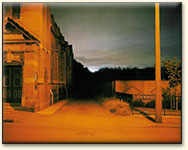Richard Billingham’s Urban Visions

Richard Billingham, Untitled, the Black Country series, 1997. This direct snapshot encourages the spectator to find out more about this lonely place, while also proposing questions and concerns about our ways of urban living.
Color changes can dramatically transform a work of art. The British artist Richard Billingham (1970) has represented his childhood neighborhood of Cradley Heath in two series of Black Country photographs. Billingham’s first series, from 1997, consists of direct snapshots that reveal degenerated urban streets, blocks of flats, car parks and backyards. These pictures encourage the spectator’s curiosity, engaging the spectator to find out more about these lonely places, while also proposing questions and concerns about our ways of urban living.

Richard Billingham, Untitled, the Black Country series, 2003. Although depicting the same area, this series emphasizes the importance of light and demonstrates how color influences that way we interpret pictures.
In 2003, Billingham revisits the same neighborhood. This time, he carries a light meter and a tripod and represents a different vision. In contrast to the earlier pictures of the degenerated urban sites, the new photographs represent atmospheric scenes, responding to the artist’s sense of mystery and poetic beauty. Although still isolated, the streets now appear mysterious, supernatural and even magical, beyond any social concerns. Billingham has changed the atmosphere by emphasizing the importance of light, which glows in the colors of intense green, yellow, blue, orange and turquoise. In doing so, his work demonstrates how color influences the ways we understand pictures.